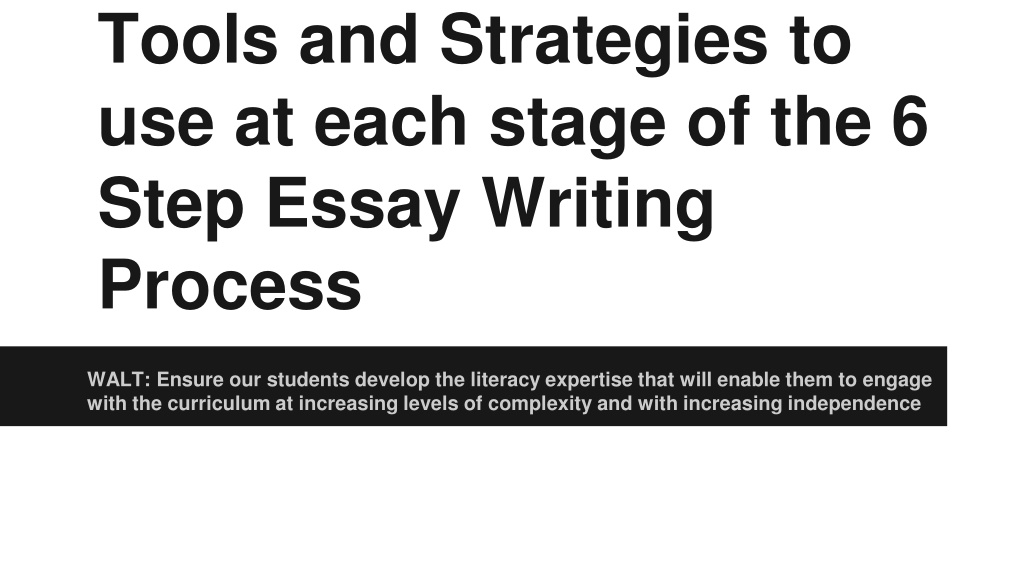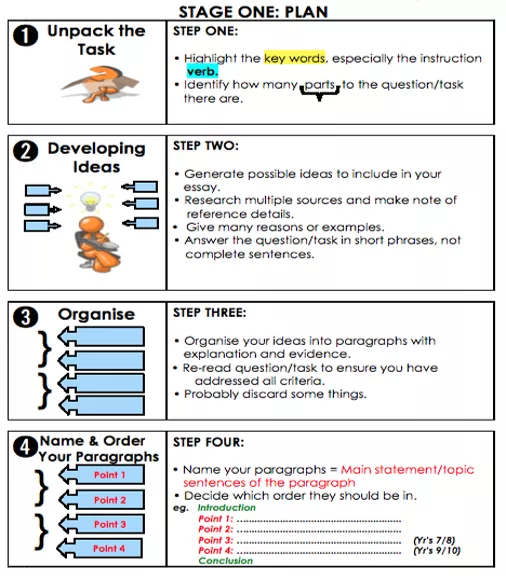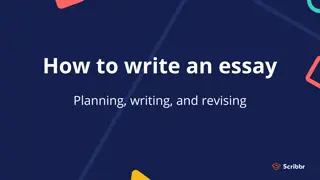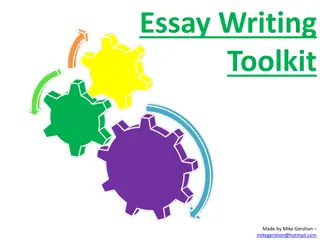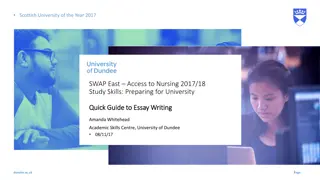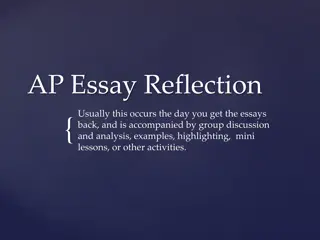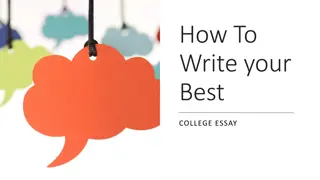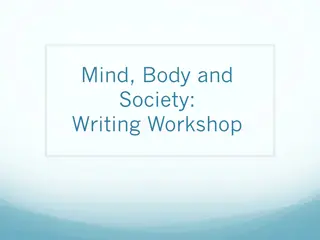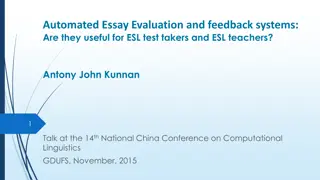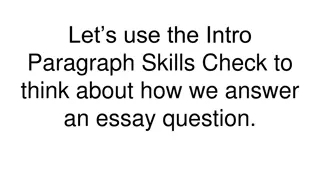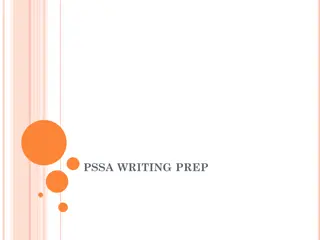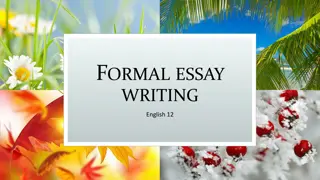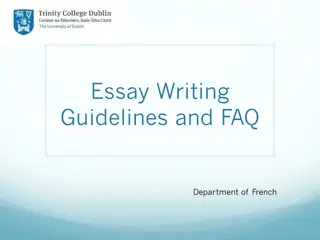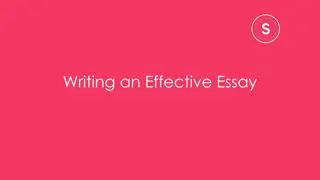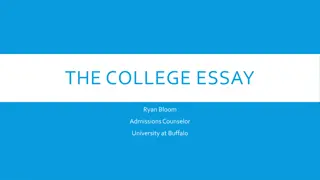Tools and Strategies for Essay Writing Process
Explore tools and strategies at each stage of the 6-step essay writing process to enhance students' literacy skills and engagement with complex curriculum content independently.
Download Presentation

Please find below an Image/Link to download the presentation.
The content on the website is provided AS IS for your information and personal use only. It may not be sold, licensed, or shared on other websites without obtaining consent from the author.If you encounter any issues during the download, it is possible that the publisher has removed the file from their server.
You are allowed to download the files provided on this website for personal or commercial use, subject to the condition that they are used lawfully. All files are the property of their respective owners.
The content on the website is provided AS IS for your information and personal use only. It may not be sold, licensed, or shared on other websites without obtaining consent from the author.
E N D
Presentation Transcript
Tools and Strategies to use at each stage of the 6 Step Essay Writing Process WALT: Ensure our students develop the literacy expertise that will enable them to engage with the curriculum at increasing levels of complexity and with increasing independence
Before Writing Strategies Refer to the MHJC 6 Step Essay Writing Process
Step 2: Generating Ideas Brainstorms: Great idea generation. The world s worst essay plan! Get students to try listing and then reviewing their list to rank their ideas to choose the topic for their paragraphs, or circle and number the most relevant ideas and then get them to transfer this a box plan .
Generating Ideas Cont... Mind mapping could be useful. Mind mapping is a creative and visual tool to develop ideas. Students can generate numerous layers of meaning and this tool can be used as a whole class, with pairs of groups adding a branch of development to the initial idea. It is a great tool for visual learners and can be part of the planning to write process for any subject or used to get students to deepen their thinking around an issue/focus.
Generating Ideas Cont... Useful websites for Mind Mapping: - https://coggle.it/ : Can be used by an individual, small groups or as a class! - https://bubbl.us/ - http://www.lifehack.org/articles/featured/11-free-mind-mapping-applications-web- services.html
Generating Ideas Cont... - 3 Level Guides Help students gather information from written texts and are designed to be used in small groups to encourage discussion and provide support Fishbone Helps students to understand cause and effect -
Organising Information Steps 3 and 4 of the 6 Step Essay Writing Process. Using a Box Plan is a good idea!
BEST PRACTICE = MODELLING Providing your students with an exemplar provides them with a clear idea of what your expectations are. You may chose to write this in advance but it is always good if you can co-construct your exemplar with your students and discuss why you are choosing in include specific information and make links back to the question/task. Eg. It s not perfect BUT it was co- constructed with the students after we had all taken part in idea generation tasks and shared our best ideas.
SEXY Paragraphs S - Statement States the topic or subject at the start of the paragraph. It is a short ONE sentence introduction to the paragraph. Each paragraph should only present ONE idea (Tip Top) eg. My lord, this man is guilty (OK, tell me more about it. I need more details)
SEXY Paragraphs E - Explain Provides the reader with further detail about the Statement . You are looking to explain a keyword from the S . This may be more than one sentence - although at Y7 one sentence should suffice. eg. He murdered Miss Scarlett, in the library, with the lead piping (Right then, prove it! I need to see some evidence)
SEXY Paragraphs X - Example Provides the reader with proof of the idea you have outlined in S and E ; supports the point you are making. This is usually quotes and references from text. eg. There is DNA evidence which links the blood on his coat to that of Miss Scarlett. His fingerprints are also on the piping. (What does this evidence mean?)
SEXY Paragraphs Y - Your Response A good way to begin this part is This shows that because... or From this the reader can understand that because... eg. Both the DNA and the fingerprints are important to link him to the case. They show incontrovertibly that he was at the scene of the crime and therefore, he committed the murder and is guilty as charged.
Have you considered using a template? Templates provide your students with definitions and prompts as well as reassurance that they are on the right track as they can refer to your exemplar - Templates can be found on the Literacy and Digital Literacy page on MHO and adapted to the needs of your students. *See your English teachers for literacy groups -
After Writing: Good writers check their writing! As our students progress in their education their teachers will be looking to see that they are crafting their writing. This means that students are revisiting their writing to rework and reshape it. They are selecting language techniques to support your ideas and structure to achieve a planned whole. Are you building in time for this?
Proofreading Guide Whatever you write, always read it over to check for mistakes in: spelling punctuation grammar and syntax (sentence structure) omission (leaving out words or phrases) You may not notice errors when reading straight through a piece of writing. People have a tendency to read what they think they wrote. That s why it s a good idea to ask someone else to read your work, to read it aloud, or even to read it backwards, sentence by sentence from the end.
Proofreading Guide Spelling Use a dictionary if you re even a little bit uncertain about a word. Some variants of common words can be difficult. Do you keep or drop the e when adding ing or ment to nouns? You can usually find those words in a dictionary too. Punctuation Don t use punctuation at random. If you re not sure where to use punctuation, it s better to use too little than too much. Apostrophes Use apostrophes to show where letters are omitted in contractions: Can t (cannot), wouldn t (would not), you re (you are), it s (it is). Use apostrophes also to show ownership: The children s toys (children own toys) The man s ideas (ideas belong to the man) The grocer s tax return (tax return belongs to the grocer) The soldiers weapons (weapons belong to the soldiers) Colons Use colons to punctuate sentences when you need to introduce a list: She was loaded with jewellery: five necklaces, a ring on every finger, a nose ring and 16 earrings. Use colons to introduce an idea suggested by the first part of a sentence. It s the equivalent of saying and here it is . Samantha had a brainwave: she would phone Paul and tell him everything. Semicolons Use semicolons to punctuate sentences when the sentences are very closely related in meaning: All the students had passed; all of them had worked very hard. Use semicolons to separate items in a list when the individual items already have commas: The landscape could be divided into flat, alluvial plains; low hills with underground waterways; and high alpine peak country, unsuitable for farming.
Proofreading Guide Grammar and syntax The main grammatical problem that crops up in student essays is lack of agreement between subject and verb. The form of the verb should always agree with the subject of the verb in number. This means that if the subject is singular, then the verb should be singular. If the subject is plural, use the verb in its plural form. Sounds simple, doesn t it? Sometimes, though, it s hard to spot the subject. subject verb 1. The football coach holds practices every weekend. The football coach hold practices every weekend. subject verb 2. The coach of our two best teams hold practices every weekend. The coach of our two best teams holds practices every weekend. In example 2, it s easy to make a mistake because the noun teams is next to the verb, and as it s a plural noun it can be mistaken for the subject of the verb. But it is the coach who holds practices, not the teams. So the coach is still the subject of the verb. You can find online grammar games here: http://freerice.com/#/english-grammar/1936308 and https://learnenglishkids.britishcouncil.org/en/grammar-games
REMEMBER: Tip Top Am I paragraphing correctly?
